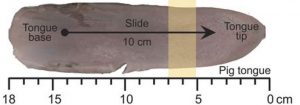46 Dataset 3: How does your brain know you are eating a fatty food?
Brokk Toggerson
When you eat a fatty food, the pleasure centers of your brain light up. How does your brain know?
This one is for those folks interested in food science or nutrition. As you may know from your scholarly pursuits or from just eating: when you ingest fatty foods the pleasure centers of your brain light up. This makes a certain evolutionary sense as fatty foods are high in calories. In our modern world, however, this feedback loop can be counter productive potentially contributing to rising levels of obesity in much of the world. Regardless, the question remains, how does your brain know that the food you are eating is fatty? Clearly, this is not based on your absorption of nutrients as that would happen much later in the digestive process. Taste may(?) play a role, but I know from my experience that fatty foods can be sour, sweet, or savory. So, the question remains, how does your brain know? A recent paper (22 November 2023!) in the Journal of Neuroscience, A Neural Mechanism in the Human Orbitofrontal Cortex for Preferring High-Fat Foods Based on Oral Texture by P. Khorisantono et al, seems to shed some light on the subject: the “mouth feel” may play a key role. They effectively measured the how slippery foods with different fat contents were and then correlated that with value.
The basic apparatus is to place liquid foods between a pig tongue (as a human analogue) and a force probe (like that on your ioLab) which they call the “slider.” Instead of the tongue sliding across the mouth, they slid the slider across the tongue. The setup is shown below. By dragging the slider across the liquid, they can measure how slippery each food was.

What you need to figure out
You will solve it a bit differently than they did. I generated data (based on their results) for an experimental procedure in which the slider is given a small initial velocity and then observed to see how its velocity changes as it slides along the analysis part of the tongue which is from 7cm to 5cm from the tip (shown below). I have made these data for three different foods: skim milk (0.08% fat), whole milk (3.25% fat), and cream (36% fat). Your ultimate goal is to determine the how slippery these foods are.

Data you may need
| Parameter | Value |
| Mass of slider | 0.29 kg |
| Initial speed | 0.7 m/s (much faster than in the original paper!) |
Kinematics
Key Questions
- How long does it take to go across the testing region in each case?
Forces
Key Questions
- What are the measured values for the slipperiness each food? Yes, there are multiple! I would make a graph of position vs. slipperiness for each.
- How does slipperiness depend on fat content?
Energy
Key Questions
- What is/are the initial and final energy(ies)?
- Where did the energy go?

